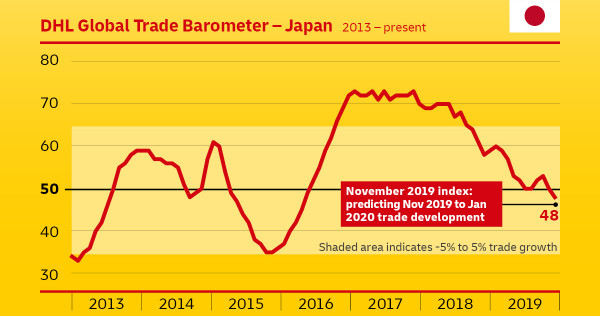- Air exports in the automobile, machinery and chemicals industry to
sustain growth despite overall trade heading towards deflation - Bullish ocean import outlook of Basic Raw Materials set to make
significant contribution to trade growth
TOKYO, JAPAN –
Media OutReach
– December 10, 2019 –
Air exports within the automobile, machinery and chemicals
industry will offer some upside to trade growth in Japan for the
three-month period ending in January 2020, even as the country’s
growth falls into negative territory, according to data from the
DHL Global Trade Barometer released by DHL, the world’s leading
logistics company.

The DHL Global Trade Barometer, an early indicator of global trade
developments calculated using Artificial Intelligence and Big Data,
predicts that Japan’s trade levels will contract in near term, with
the country’s index value decreasing by five points to 48 points —
below the no-growth threshold of 50 points on the Index.[1]
The negative growth stems primarily from shrinking air trade
across industries, though certain core sectors like automobile
manufacturing are expected to remain relatively strong and offset
the significant decline in other export areas.[2]
“Despite a contraction in the forecast for the next three months,
Japan’s trade outlook remains relatively robust thanks to the
strong base provided by core industries such as automotive
manufacturing, machinery and technology,” said Charles Kaufmann,
CEO North Asia South Pacific, DHL Global Forwarding. “Exports for
Land Vehicles & Parts look set to make notable contributions to
trade growth off the back of industry consolidation and greater investment
in electric and self-driving vehicles. We also see the upcoming
Tokyo 2020 Olympic Games contributing to the bullish outlook for
imports of Basic Raw Materials over the next quarter, with the
Games expected to have positive impacts on the Japanese economy
across the board.”
Steady but mild decline negatively affects all countries, except
India
The Barometer’s results also suggest that world trade is expected
to continue at moderate pace but further contract for the next
three months, driven by minor decreases in both air and
containerized ocean trade. Against previous quarters this year, the
downward trend in trade growth remains mostly stable, neither
indicating an acceleration of the decline nor a bottoming out of
contractionary movement. All seven nations monitored by the
Barometer received indexes below 50 points except for India, where
the Barometer forecasts moderate growth of five points to 54 points
for India. While Japan and the UK had been the only countries with
positive trade outlooks in the previous update in September, the
two countries record the highest losses in this period.
“According to the DHL Global Trade Barometer the year will probably
end with moderate world trade. However, we’ve to bear in mind where
we come from: The rapid growth world trade has undergone in recent
years was like climbing the Mount Everest. Now, we are on the
descent, but we are still breathing altitude air”, Tim Scharwath,
CEO of DHL Global Forwarding, Freight, says. “A countless number of
stable trade relations continues to flourish worldwide, despite
smouldering trade conflicts and geopolitical uncertainties.”
[1]
In the Global Trade Barometer methodology, an index value above 50
indicates positive growth, while values below 50 indicate
contraction.
[2]
Click here
for more information on the outlook for air freight and ocean
freight or the key sectors in Japan.
Note to editors:
The proposed Regional Comprehensive Economic Partnership (RCEP)
will boost market access to products and capital, and create the
world’s largest regional trading bloc that will account for more
than 29.1 percent of global trade.
Read more
about Asia’s next trade pact and its impact on global trade.
About the Global Trade Barometer
Launched in January 2018, the DHL Global Trade Barometer is an
innovative and unique early indicator for the current state and
future development of global trade. It is based on large amounts of
logistics data that are evaluated with the help of artificial
intelligence. The indicator is published four times a year and the
next release date is scheduled for end of March 2020.
For more information on the DHL Global Trade Barometer, please
visit: logisticsofthings.dhl/gtb
. The index is now also available for subscribers of the Bloomberg
terminal by using the code “DHLG <GO>”.
DHL — The logistics company for the world
DHL
is the leading global brand in the logistics industry. Our DHL
family of divisions offer an unrivalled portfolio of logistics
services ranging from national and international parcel delivery,
e-commerce shipping and fulfillment solutions, international
express, road, air and ocean transport to industrial supply chain
management. With about 380,000 employees in more than 220 countries
and territories worldwide, DHL connects people and businesses
securely and reliably, enabling global trade flows. With
specialized solutions for growth markets and industries including
technology, life sciences and healthcare, energy, automotive and
retail, a proven commitment to corporate responsibility and an
unrivalled presence in developing markets, DHL is decisively
positioned as “The logistics company for the world”.
DHL is part of Deutsche Post DHL Group. The Group generated
revenues of more than 61 billion euros in 2018.




